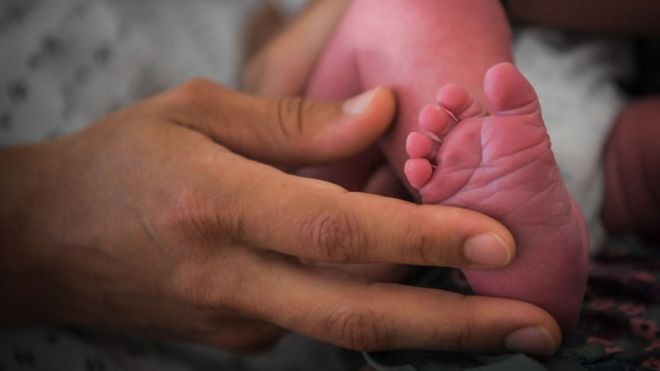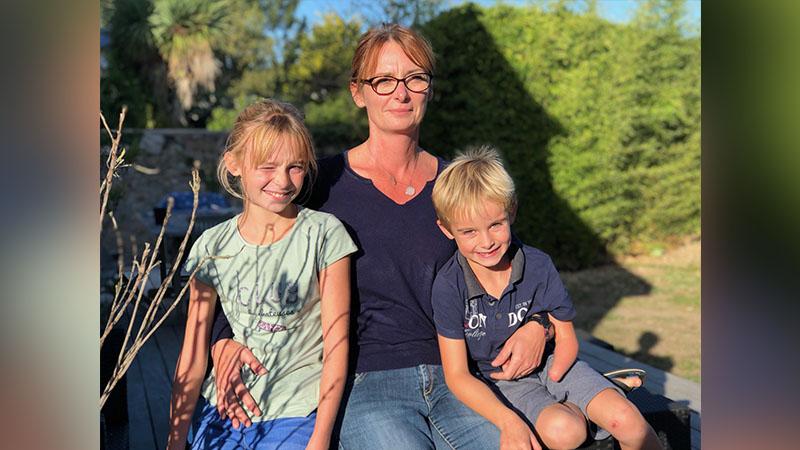
A cluster of birth defect cases was initially dismissed, but several more have now emerged
France has launched a national investigation into the number of babies being born with missing arms or hands - weeks after an initial inquiry closed. The first investigation began after it emerged more than a dozen children had been born with the condition in clusters in three French regions. It ended after health authorities failed to identify a common cause.
But now another 11 cases have emerged in the eastern region of Ain, prompting officials to open a fresh inquiry.
The condition is a type of agenesis, where the upper limbs of a foetus fail to form correctly during pregnancy. It includes entire missing upper limbs, missing forearms and hands, or fingers - but not unrelated medical conditions, such as missing thumbs.
The cases are clustered in the rural Ain area not far from the Swiss border, as well as in Brittany and Loire-Atlantique, two neighbouring regions on the north-west coast.
Health Minister Agnès Buzyn had already pledged a further investigation in the wake of the initial report's lack of explanations, amid continued public concern and widespread media coverage.
Speaking on French television on Wednesday morning, she said the first results from the national inquiry would be published in January, with more to follow by summer.
"I think all of France wants to know," said Ms Buzyn. "We don't want to rule anything out. Perhaps it's do with the environment, or something they ate, or something they drank. Perhaps it's what they breathed - right now I just don't know."
All the cases reported in Ain involve people within a 17km (11 miles) radius of the village of Druillat, leading to speculation about the possible influence of pesticides - which has yet to be proven.
The stories of some affected children were widely covered in the French media in the wake of the first report. Ryan, now aged eight, is one of the children from the Ain region who is missing a hand.
His parents told French news channel Franceinfo that there had been no hint of a problem on ultrasound scans. Instead they found out when he was born, and doctors were unable to tell them why.

Ryan, born with missing hand
The regional register for birth defects, Remera, had raised concerns about a possible surge in cases in Ain in July, following reports from local doctors. It discovered seven cases clustered close together around Druillat over six years.
But an initial report from Public Health France in October concluded that those cases, between 2009 and 2014, were not significantly higher than the national average. However, it now says that the 11 new cases it uncovered were all from Ain, covering 15 years since 2000. Three other cases in Loire-Atlantique and four in Brittany were also looked at. In those cases, the health body acknowledged that the numbers were higher than average - but again, no common cause was found. Officials concluded that in all three regions, further investigations were not possible without a hypothesis to pursue.
Another affected mother, from Brittany, said she was quizzed by doctors after the birth of her son Leo with a malformed forearm. They wanted to know about eating habits or any pharmaceuticals or drug use - but again, could not find a cause.
Chair of the scientific committee in Ain's regional health centre, geneticist Dr Elizabeth Gnansia, said the number of concentrated cases of a rare condition was significant.
"Let's imagine they are born between 2009 and 2014, which is five years, can you imagine that in a small rural school seven infants are in the same school with a type of amputation of forearm?" she said.
"We don't need statistics for that. It's highly significant. It's 50 times what you expect."
The report also said that monitoring of birth defects was only carried out by a handful of registers, covering just 19% of births in France. That has prompted some fears that the number of cases may be under-reported.
On Tuesday, Public Health France announced that the new cases had been uncovered by a further analysis of hospital databases. It warned that a comprehensive survey several years after the birth of affected children would be "complex".
The case has drawn parallels with the Thalidomide scandal, involving a drug often taken by pregnant women to alleviate morning sickness. The link between Thalidomide and limb malformation during pregnancy was only uncovered after years of the drug's use.
However, no such link between a chemical or pharmaceutical cause has been drawn in France.
Generally cases like this are discovered to be the result of some toxic substance in the air, water, drugs or food ingested by them mother. Industrial discharge, chemicals from fertilizers, some newly developed insecticide and even new pharmaceutical products can all be a possible cause of such birth defects if the mother has been exposed to them in the first trimester of her pregnancy.
As usual, we are more in danger of destroying ourselves than in being destroyed by some other species or disease. Here's hoping French researchers come up with the answer soon.
No comments:
Post a Comment
Through this ever open gate
None come too early
None too late
Thanks for dropping in ... the PICs